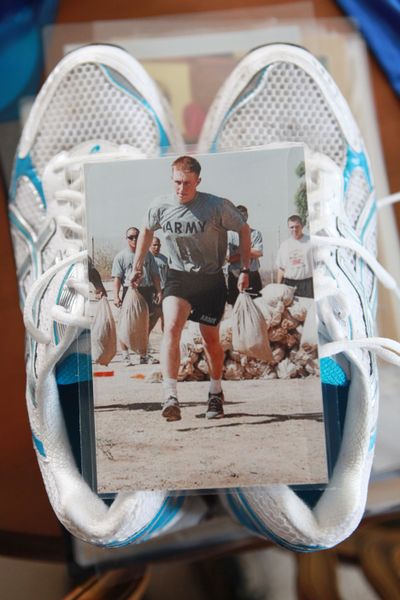Runners’ memorial moving to form swath of blue at marathon

SEATTLE – When Lisa Hallett’s life felt abstract and upside down, she turned to the one thing she could control: She went for a run.
It was August 2009 and she had just learned her husband, Army Capt. John Hallett, had been killed with three other soldiers after an IED hit the Stryker vehicle transporting him back from a good-will mission in southern Afghanistan.
Lisa had given birth to Heidi, the couple’s third child, a few weeks earlier. She was suddenly filled with emptiness. She couldn’t think. She couldn’t feel. But she could move.
“Everything is just raw and it’s overwhelming,” Lisa said. “A lot of sorrow emerges from facing a lifetime without your husband. You’re right here at the brink of your life without your best friend, the person you love more than life itself. You’re facing forever without him, the rest of your life without that person.”
Lisa used motion and mileage to work through the grieving process. Almost two years later, she’s still running.
She turned the coping mechanism into a way to celebrate her husband’s memory and the lives of other soldiers killed in combat. At the third annual Rock ’n’ Roll Seattle Marathon on Saturday, she was to be joined by other members of wear blue: run to remember – the organization she co-founded. They aimed to form a swath of blue, a living memorial running among more than 26,000 race participants.
Two days after Lisa heard the news of John’s death, she put on her running shoes and met her friend Carrie. They took off down a trail near DuPont. It was quiet. They didn’t go far. Because she just had a baby, Lisa wasn’t supposed to run. She did it anyway, putting one foot in front of the other as she processed her grief.
“There were days I’d hit the corner and I’d stop and cry and that’s all I could do,” Lisa said.
She kept running, and the 5th Stryker Brigade – deployed out of Joint Base Lewis-McChord – continued to experience casualties. More spouses turned to running. Then they started to run together, and a few ran the Seattle Marathon in November 2009.
A few months later, they made the group official, meeting in the parking lot of an on-base Burger King to run around the nearby airfield. That first group of 12, wearing blue Army physical-training shirts – John’s favorite color – grew to the 23 who participated in the 2010 Rock ’n’ Roll Marathon in Seattle. A year later, wear blue: run to remember has grown to more than 250 members who were planning to be in Seattle as runners or supporters.
“I’m really passionate about running as a coping mechanism and as a healing device,” said Erin O’Connor, who co-founded the organization with Hallett. “I think this (the marathon) is just the kind of thing that pulls it all together.”
At the start of this year’s marathon, the group planned to line up in the 17th corral – John was in the 1-17th Infantry – wearing matching blue shirts. The announcer was to read the names of 43 soldiers killed and, when the race began, they were to create a living memorial moving along the course.
They also planned to operate a water station 7 1/2 miles into the race as the course bends around Lake Washington. Competitors would first pass a sign that reads “wear blue: run to remember.” A second sign would read, “Honoring the service and sacrifice of the American military.” Full-size American flags were to each have a black ribbon with the name of a soldier embroidered in gold. John Hallett’s flag was to be held by his parents, John and Wendy.
“We want to humanize the loss,” Lisa Hallett said. “John’s not a number, he’s my husband. He’s my best friend. He likes Jack in the Box. He doesn’t like to shave on the weekends. He’s a very real person who lived a very real life. But when you don’t know John, he does become a number and just another casualty. We really want people to connect with the faces and the families and the realness of this loss.”